Climbing Roses in Pots: Tips and Tricks for Growing Beautiful Blooms
Climbing roses are a beautiful addition to any garden, but not everyone has the space to accommodate them. Fortunately, growing climbing roses in pots is a practical solution for those with limited space. Potted roses offer flexibility in terms of placement, allowing gardeners to move them around as needed to take advantage of the best sunlight or to create a stunning focal point.
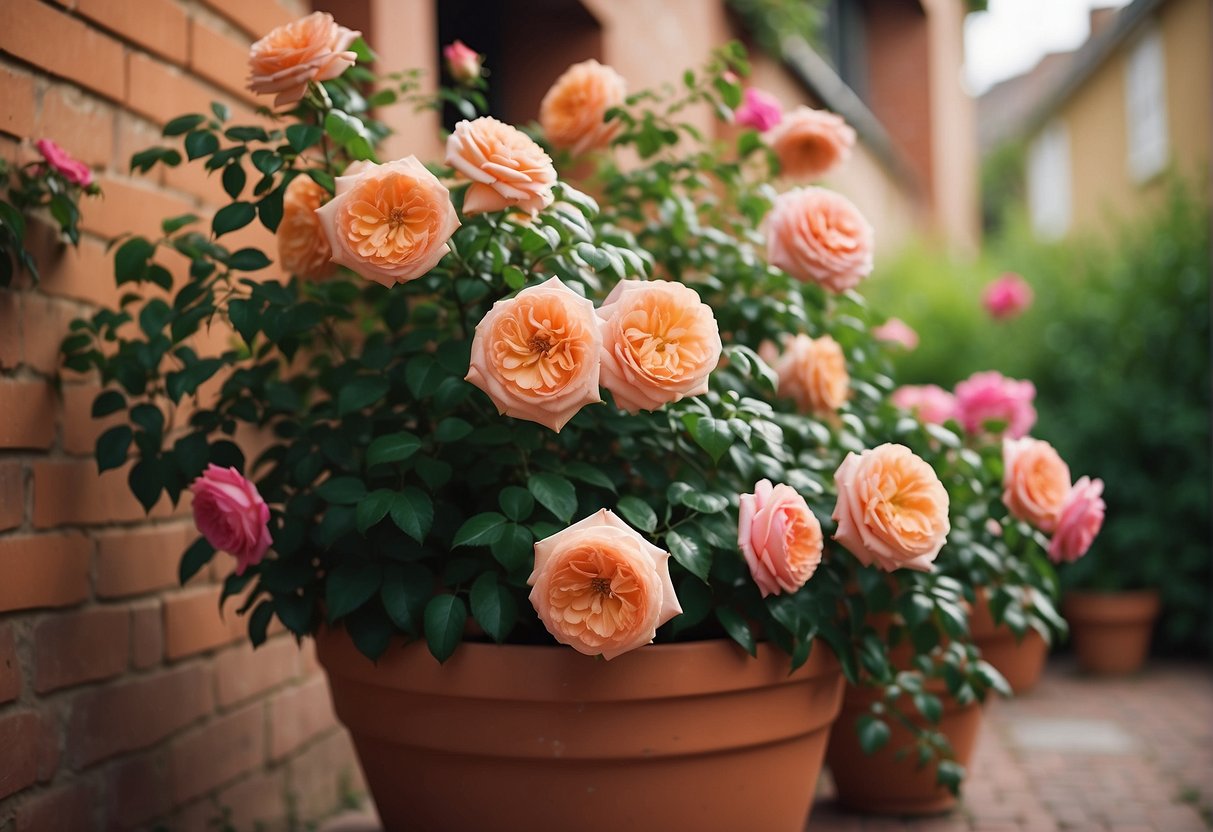
While roses are often associated with being planted in the ground, they can thrive in pots as well. In fact, growing climbing roses in pots can be advantageous for several reasons. Firstly, it allows gardeners to control the soil quality and drainage, which can be especially important in areas with poor soil. Secondly, potted roses can be moved indoors during the winter months, which can help protect them from harsh weather conditions. Lastly, growing climbing roses in pots can be a great option for renters or those who are planning to move, as they can easily take their roses with them.
Overall, climbing roses in pots are a versatile and practical option for those who love roses but have limited space. With the right care and attention, potted roses can thrive and create a stunning display in any garden or patio.
Choosing the Right Climbing Roses for Pots
Climbing roses are a great way to add vertical interest to your garden, but what if you don’t have a lot of space? That’s where climbing roses in pots come in. With the right care and attention, you can grow beautiful climbing roses in containers. Here’s what you need to know to choose the right climbing roses for pots.
Varieties and Types
When it comes to choosing climbing roses for pots, there are a few things to consider. First, make sure you choose a variety that is well-suited for container growing. Some popular varieties for pots include:
- ‘Zephirine Drouhin’: A fragrant, pink climbing rose that is well-suited for container growing.
- ‘New Dawn’: A pale pink climbing rose that is disease-resistant and easy to grow in pots.
- ‘Blaze’: A bright red climbing rose that is well-suited for pots and has a long blooming season.
It’s also important to consider the type of climbing rose you want to grow. Some climbing roses, like ramblers, are more vigorous and may not be well-suited for container growing. Instead, look for climbing roses that are more compact and have a more manageable growth habit.
Pot Size and Material
When it comes to growing climbing roses in pots, size matters. Make sure you choose a pot that is large enough to accommodate your rose’s root system. A good rule of thumb is to choose a pot that is at least 18 inches in diameter and 18 inches deep.
In terms of material, plastic containers are a good choice for growing climbing roses in pots. They are lightweight, easy to move, and won’t crack or break in cold weather. Just make sure to choose a container with drainage holes to ensure proper drainage.
Overall, choosing the right climbing roses for pots comes down to selecting a variety that is well-suited for container growing and choosing the right pot size and material. With the right care and attention, you can enjoy beautiful climbing roses in pots for years to come.
Planting and Repotting
Soil Composition
The right soil composition is crucial for the growth and health of climbing roses in pots. A well-draining soil mix that is rich in nutrients and organic matter will provide the necessary support for the plant to thrive. A good soil mix for climbing roses in pots should contain equal parts of compost, perlite, and garden soil.
Drainage and Potting
Good drainage is essential for climbing roses in pots as excess water can cause root rot and other diseases. It is important to ensure that the pot has sufficient drainage holes at the bottom. When potting climbing roses, make sure to use a pot that is at least 18 inches deep and 16 inches wide. This will provide enough space for the root ball to grow and spread.
Planting Techniques
When planting climbing roses in pots, it is important to follow the right techniques to ensure that the plant thrives. If planting bare root roses, soak the roots in water for a few hours before planting. When planting, make a hole in the soil mix that is deep enough to accommodate the root ball. Spread the roots out in the hole and cover with soil mix, making sure that the plant is firmly anchored in the pot.
Repotting climbing roses in pots should be done every two to three years to ensure that the plant has enough space to grow. To repot, gently remove the plant from the pot and loosen the roots. Use a larger pot and follow the same planting techniques as above. Water the plant thoroughly after repotting and place it in a sunny spot.
By following the right planting and repotting techniques, climbing roses in pots can thrive and provide a beautiful addition to any garden or patio.
Caring for Potted Climbing Roses
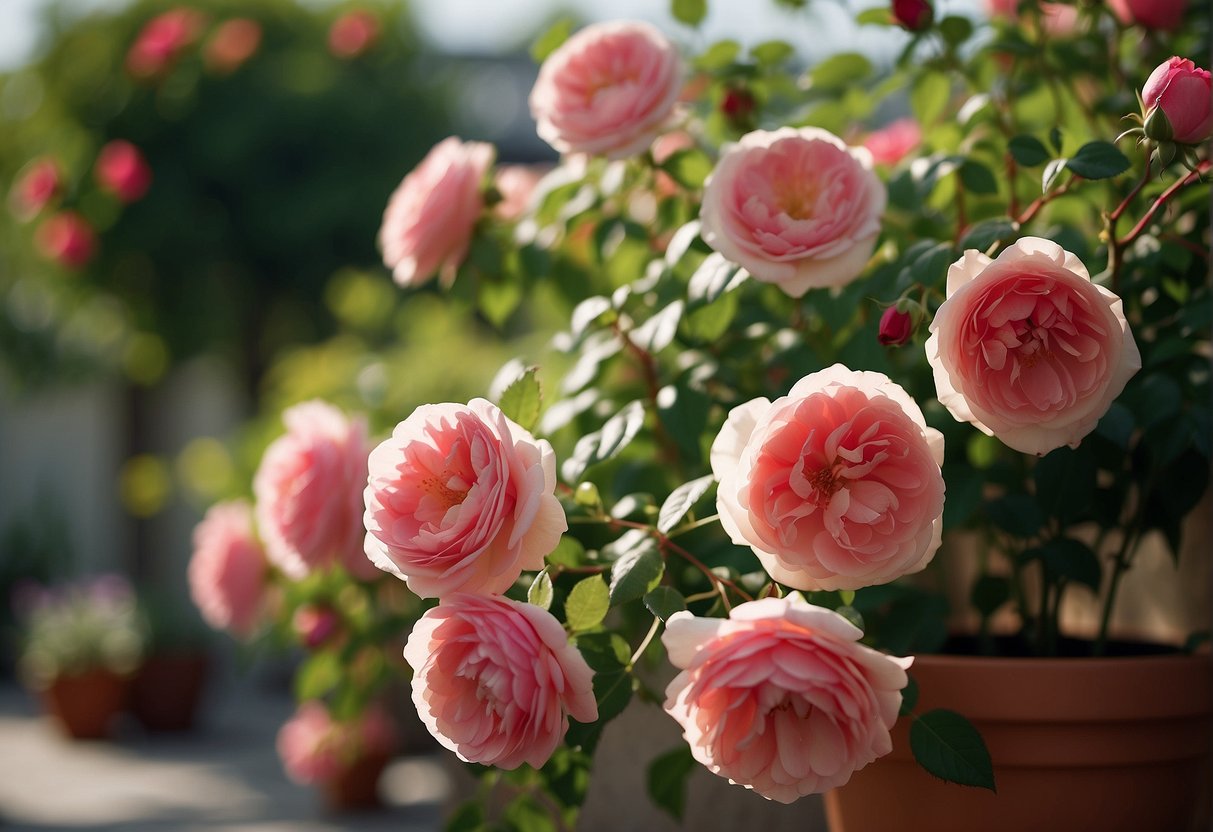
Climbing roses in pots are a beautiful addition to any garden or balcony. They add height, color, and fragrance to any space. However, caring for potted climbing roses can be a bit tricky. Here are some tips to keep your climbing roses healthy and blooming.
Watering and Nutrients
Watering is crucial for potted climbing roses. They need regular watering, especially during the hot summer months. The soil should be kept moist but not waterlogged. Overwatering can lead to root rot and other problems. It is recommended to water deeply once a week rather than light watering every day.
Nutrients are also important for the growth and blooming of climbing roses. Fertilize your climbing roses with a balanced fertilizer every four to six weeks during the growing season. Use a slow-release fertilizer for container plants, or a liquid fertilizer that is diluted in water.
Pruning and Training
Pruning is necessary to keep your climbing roses healthy and in shape. Prune your climbing roses in late winter or early spring before new growth begins. Remove any dead, diseased, or damaged wood, and cut back any crossing branches.
Training your climbing roses is important to ensure they grow in the desired direction. Tie the main stem to a trellis or support, and train the lateral branches to grow along the support. This will create a beautiful and full display of blooms.
Winter Care and Protection
Climbing roses in pots need protection during the winter months. Move your potted roses to a sheltered location, such as a garage or shed, to protect them from harsh winds and freezing temperatures. Mulch around the base of the plant with straw or leaves to insulate the roots.
Deadheading is also important during the winter months. Remove any spent blooms to prevent disease and encourage new growth in the spring.
In conclusion, caring for potted climbing roses requires regular attention and care. By following these tips for watering, nutrients, pruning, training, and winter care, you can ensure your climbing roses will bloom beautifully year after year.
Pest and Disease Management
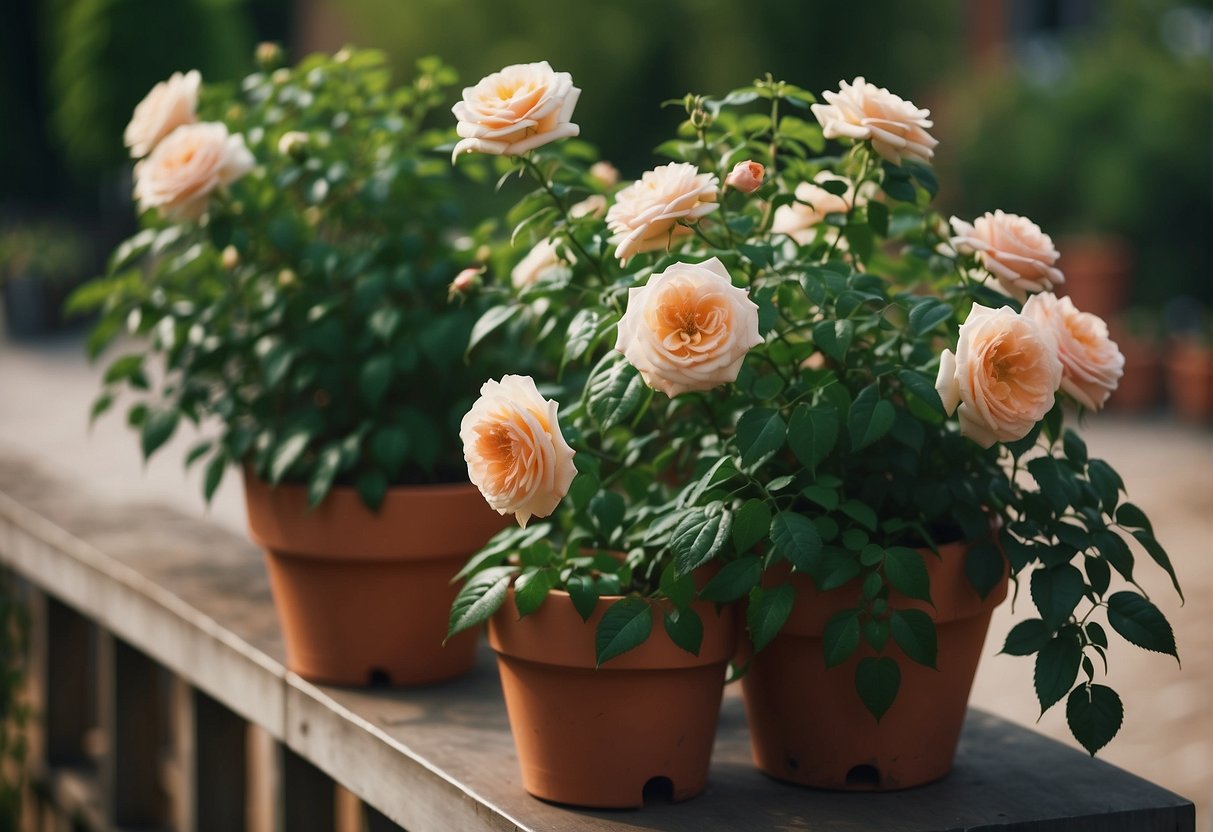
Common Pests
Climbing roses in pots are vulnerable to a variety of pests. Aphids are one of the most common pests that can infest climbing roses. They feed on the foliage of the plant and can cause the leaves to curl and distort. To control aphids, one can use insecticidal soap or neem oil spray. Regularly inspecting the plant for aphids and removing them by hand can also be effective.
Spider mites are another common pest that can damage climbing roses. They are tiny and difficult to see with the naked eye. They feed on the foliage of the plant, causing it to turn yellow and eventually fall off. To control spider mites, one can use a miticide spray or introduce natural predators like ladybugs or lacewings.
Disease Prevention
Climbing roses in pots are also susceptible to diseases, especially if they are not properly cared for. Fungal diseases like black spot and powdery mildew can affect the foliage of the plant, causing it to yellow and drop prematurely. To prevent fungal diseases, one can ensure proper air circulation around the plant, avoid overhead watering, and remove any infected leaves as soon as they are noticed.
Disease-resistant varieties of climbing roses are also available and can be a good option for those who want to minimize the risk of disease. It is important to choose a variety that is resistant to the specific diseases that are prevalent in the area.
Regularly inspecting climbing roses in pots for pests and diseases can help prevent infestations and infections. Using appropriate sprays and treatments can also help control pests and diseases and keep climbing roses healthy and beautiful.
Design and Aesthetics
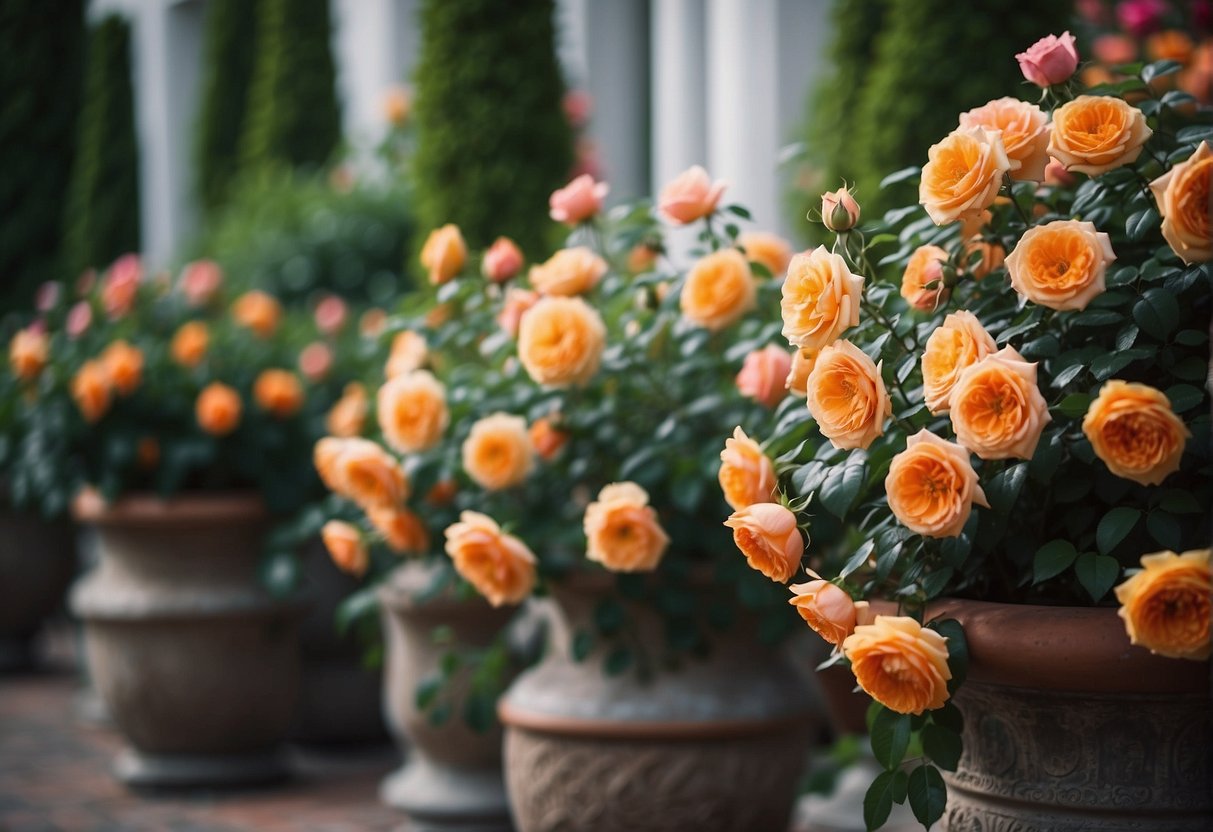
Support Structures
Climbing roses in pots require a sturdy support structure to grow and thrive. The support structure should be strong enough to hold the weight of the rose plant as it grows and blooms. Gardeners can choose from a variety of support structures, such as trellises, fences, arbors, gazebos, or pergolas. The support structure should be placed in a location that receives full sun or partial shade, as climbing roses require sunlight to grow and bloom.
Arrangement and Display
When arranging climbing roses in pots, gardeners should consider the overall aesthetic of the garden or outdoor space. Climbing roses can be arranged in a variety of ways, such as against a wall, on a fence, or around a support structure. Gardeners should also consider the color and bloom of the roses when arranging them in pots.
To create a visually appealing display, gardeners can mix different varieties of climbing roses with complementary colors and growth patterns. Alternatively, they can choose a single variety of climbing rose and arrange them in a symmetrical or asymmetrical pattern.
Overall, climbing roses in pots can add a beautiful and vibrant touch to any outdoor space. With the right support structure and arrangement, gardeners can enjoy the vigorous growth and stunning blooms of climbing roses for years to come.
Frequently Asked Questions
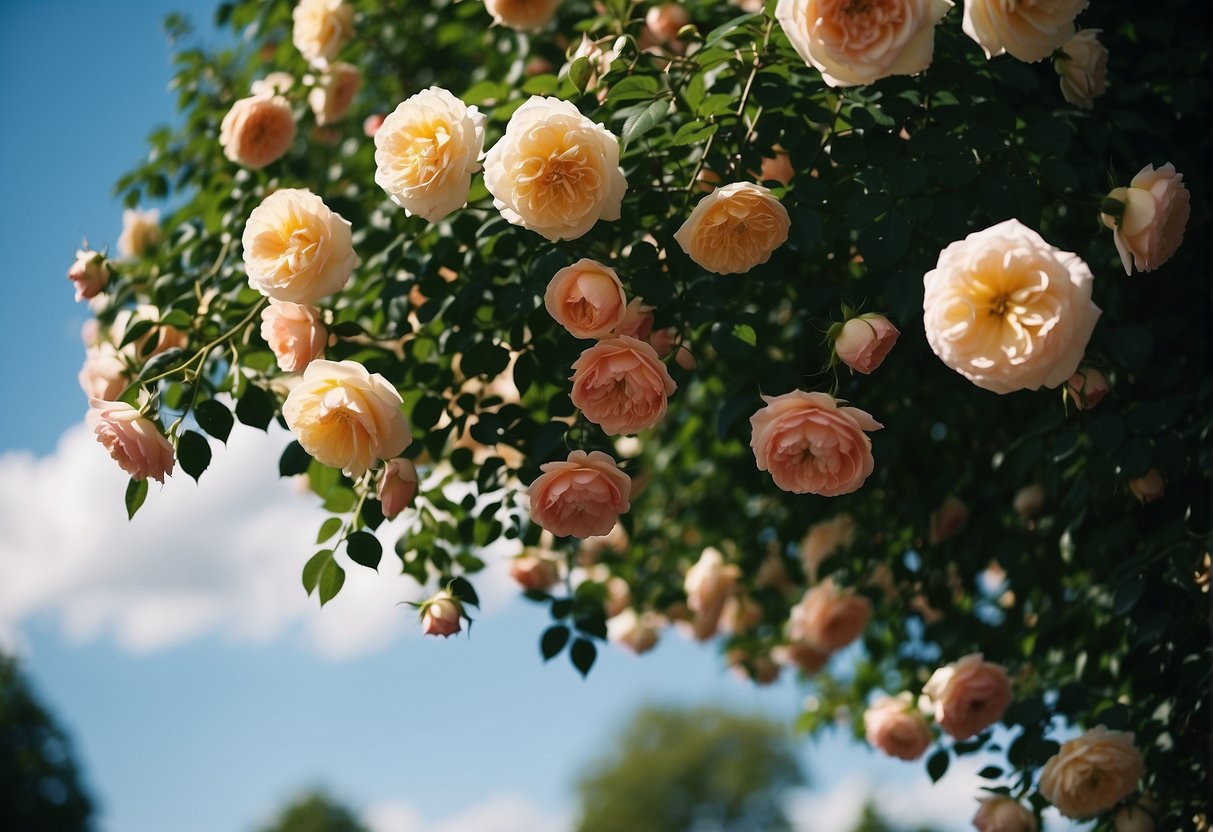
What type of trellis is best for supporting climbing roses in containers?
When growing climbing roses in pots, it is important to provide them with a sturdy trellis to support their growth. A trellis made of wood or metal is ideal, as it provides stability and strength. The trellis should be tall enough to allow the rose to grow to its full height, and wide enough to provide ample support for the plant.
How do you properly plant and care for a climbing rose in a pot?
To plant a climbing rose in a pot, choose a container that is at least 18 inches in diameter and 18 inches deep. Fill the pot with a high-quality potting mix and plant the rose at the same depth it was growing in its nursery pot. Water the rose thoroughly and place it in a location that receives at least 6 hours of sunlight per day. Water the rose regularly and fertilize it every 4-6 weeks during the growing season.
Which climbing rose varieties are most suited for growing in pots?
Many climbing rose varieties are well-suited for growing in pots, including ‘Blaze’, ‘New Dawn’, and ‘Zephirine Drouhin’. When selecting a climbing rose for container growing, look for varieties that are disease-resistant, have a compact growth habit, and bloom repeatedly throughout the growing season.
What are common issues faced when cultivating roses in pots and how can they be addressed?
Common issues faced when cultivating roses in pots include overwatering, underwatering, and pest infestations. To address these issues, make sure to water the rose regularly but not excessively, and monitor the plant for signs of pests such as aphids or spider mites. If pests are present, treat the plant with an appropriate pesticide.
How much sunlight is required for potted climbing roses to thrive?
Potted climbing roses require at least 6 hours of sunlight per day to thrive. When selecting a location for your rose, choose a spot that receives full sun for most of the day. If your rose is not receiving enough sunlight, it may not bloom as well or may become weak and susceptible to disease.
What is the ideal soil mixture for climbing roses in containers?
The ideal soil mixture for climbing roses in containers is a well-draining potting mix that is rich in organic matter. A mixture of peat moss, perlite, and compost works well. Avoid using heavy garden soil or soil that is compacted, as this can lead to poor drainage and root rot.
